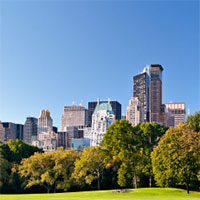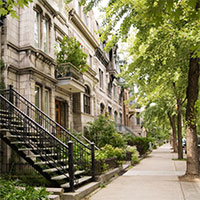Tree Facts
What can a tree do for you? A lot. Check out all the ways—sometimes unexpected—that trees positively affect us, our communities, and our world.
 Trees help clean our air.
Trees help clean our air.
- Global forests removed about one-third of fossil fuel emissions annually from 1990 to 2007.
share U.S. Forest Service, 2011 - Trees remove pollution from the atmosphere, improving air quality and human health.
share U.S. Forest Service, 2013- In Los Angeles, trees remove nearly 2,000 tons of air pollution each year.
share U.S. Forest Service, 2011 - In Chicago, trees remove more than 18,000 tons of air pollution each year.
share U.S. Forest Service, 2013 - In Greater Kansas City, trees remove 26,000 tons of air pollution each year.
share U.S. Forest Service, 2013
- In Los Angeles, trees remove nearly 2,000 tons of air pollution each year.
- Roadside trees reduce nearby indoor air pollution by more than 50%.
share Lancaster University, United Kingdom, 2013
 Trees contribute to our health.
Trees contribute to our health.
- A study of 10 cities found community forests save an average of one life each year. In New York City, trees save an average of eight lives every year.
share U.S. Forest Service, 2013 - Office workers with a view of trees report significantly less stress and more satisfaction.
share Chungbuk National University, South Korea, 2007
 Trees provide us with oxygen.
Trees provide us with oxygen.
- One large tree can provide a day’s supply of oxygen for up to four people.
share North Carolina State University - More than 20% of the world’s oxygen is produced in the Amazon Rainforest
share Rain Forest Alliance
 Trees help clean our drinking water.
Trees help clean our drinking water.
- Forested watersheds provide quality drinking water to more than 180 million Americans.
share U.S. Forest Service, 2013 - In 1997, New York City spent $1.5 billion to preserve the forested watershed that supplies New York City’s drinking water by purchasing thousands of upstate acres of forested watershed. A filtration plant large enough to clean New York City’s water supply would have cost more than $6 billion dollars.
share Ecosystem Marketplace, 2006- Today, New Yorkers enjoy some of the cleanest drinking water in the world, and New York City has won regional water taste competitions.
share New York City Department of Environmental Protection, 2013
- Today, New Yorkers enjoy some of the cleanest drinking water in the world, and New York City has won regional water taste competitions.
 Trees provide much-needed cooling.
Trees provide much-needed cooling.
- Trees lower surface and air temperatures by providing shade. Shaded surfaces may be 20–45°F cooler than the peak temperatures of unshaded materials.
share U.S. EPA- Trees cool the city by up to 10°F by shading our homes and streets and releasing water vapor into the air through their leaves.
- Evaporation of water from trees has a cooling influence.
share Carnegie Institution, 2011
 Trees help reduce the effects of climate change.
Trees help reduce the effects of climate change.
- Trees absorb carbon dioxide (CO2), removing and storing the carbon while releasing the oxygen back into the air.
- In one year, an acre of mature trees absorbs the amount of CO2 produced by a car driven 26,000 miles.
- During one year, a mature tree will absorb more than 48 pounds of carbon dioxide from the atmosphere and release oxygen in exchange.
share European Environment Agency- Nearly 20 pounds of carbon dioxide are produced from burning one gallon of non-ethanol gasoline.
share U.S. Energy Information Administration
- Nearly 20 pounds of carbon dioxide are produced from burning one gallon of non-ethanol gasoline.
 Trees help us save energy.
Trees help us save energy.
- Trees properly placed around buildings can reduce air conditioning needs by 30% and can save 20–50% in energy used for heating.
share U.S. Forest Service- The average Cincinnati community tree saves the average household $56 annually in cooling costs by reducing electricity use. More than 85,000 Cincinnati community trees save residents $4.8 million.
2011
- The average Cincinnati community tree saves the average household $56 annually in cooling costs by reducing electricity use. More than 85,000 Cincinnati community trees save residents $4.8 million.
- Carefully positioned trees can reduce a household’s energy consumption for heating and cooling by up to 25%. Computer models devised by the U.S. Department of Energy predict that the proper placement of only three trees can save an average household between $100 and $250 in energy costs annually.
share Energy.gov
 Trees benefit wildlife.
Trees benefit wildlife.
- Trees provide vital wildlife habitat.
share U.S. Forest Service, 2010- In British Columbia, Canada, more than 80 wildlife species depend on trees.
share Ministry of Environment, Lands and Parks, British Columbia
- In British Columbia, Canada, more than 80 wildlife species depend on trees.
- Trees and forests provide important species range. Many animals have a range of hundreds of square miles. The mountain lion of North America, for instance, has a range of nearly 400 square miles.
share National Geographic
 Trees help reduce crime.
Trees help reduce crime.
- In Baltimore, a 10% increase in tree canopy corresponded to a 12% decrease in crime.
share University of Vermont and U.S. Forest Service, 2012 - Among minor crimes, there is less graffiti, vandalism and littering in outdoor spaces with trees as a part of the natural landscape than in comparable plant-less spaces.
share University of Washington - Chicago public housing residents with nearby trees and natural landscapes reported 25% fewer acts of domestic aggression and violence.
share University of Illinois, Urbana-Champaign, 2001
 Trees are a good investment of our public dollars
Trees are a good investment of our public dollars
- Every dollar spent on planting and caring for a community tree yields benefits that are two to five times that investment—benefits that include cleaner air, lower energy costs, improved water quality and storm water control and increased property values.
share U.S. Forest Service, 2011- In Indianapolis, each dollar invested in the city’s community trees yielded $5.55 in benefits.
share State of Indiana DNR, 2008 - In New York City, it has been calculated that community trees provide $5.60 in benefits for every dollar spent on tree planting and care.
share 2007 - In Cincinnati, the return on a $1 investment in the city’s community trees is $4.44.
share 2011
- In Indianapolis, each dollar invested in the city’s community trees yielded $5.55 in benefits.
- The mature street trees in Beverly Hills, California, are worth $450 million.
share 1991 - A cost-benefit analysis of the Berkeley, California, tree canopy indicated that each camphor tree had an annual net benefit to the city and its residents of nearly $12,500, each shamel ash showed a $9,600 annual net benefit, and each London planetree had an annual net benefit of more than $8,700 per tree.
share 2005
 Trees increase our property values.
Trees increase our property values.
- In Portland, Oregon, homes with street trees sold for $7,130 more, on average, and 1.7 days more quickly.
share U.S. Forest Service, 2008- Neighboring houses within 100 feet of street trees sold for $1,688 more, on average.
- The sale premium of having street trees was the same as adding 129 square feet of finished space.
- In Fulton County (Atlanta), Georgia, mature trees positively influenced home sale prices. Homes sold for nearly $105,000 more in neighborhoods with mature trees.
share University of Georgia, 2002
Benefits of Trees
Trees can add value to your home, help cool your home and neighborhood, break the cold winds to lower your heating costs, and provide food for wildlife.
The Value of Trees to a Community
The following are some statistics on just how important trees are in a community setting.
The net cooling effect of a young, healthy tree is equivalent to ten room-size air conditioners operating 20 hours a day. U.S. Department of Agriculture
If you plant a tree today on the west side of your home, in 5 years your energy bills should be 3% less. In 15 years the savings will be nearly 12%. Dr. E. Greg McPherson, Center for Urban Forest Research
A mature tree can often have an appraised value of between $1,000 and $10,000. Council of Tree and Landscape Appraisers
In one study, 83% of realtors believe that mature trees have a ‘strong or moderate impact’ on the salability of homes listed for under $150,000; on homes over $250,000, this perception increases to 98%. Arbor National Mortgage & American Forests
Landscaping, especially with trees, can increase property values as much as 20 percent. Management Information Services/ICMA
One acre of forest absorbs six tons of carbon dioxide and puts out four tons of oxygen. This is enough to meet the annual needs of 18 people. U.S. Department of Agriculture
There are about 60– to 200-million spaces along our city streets where trees could be planted. This translates to the potential to absorb 33 million more tons of CO2 every year, and saving $4 billion in energy costs. National Wildlife Federation
Trees properly placed around buildings can reduce air conditioning needs by 30 percent and can save 20–50 percent in energy used for heating. USDA Forest Service
Trees can be a stimulus to economic development, attracting new business and tourism. Commercial retail areas are more attractive to shoppers, apartments rent more quickly, tenants stay longer, and space in a wooded setting is more valuable to sell or rent. The Arbor Day Foundation
Healthy, mature trees add an average of 10 percent to a property’s value. USDA Forest Service
The planting of trees means improved water quality, resulting in less runoff and erosion. This allows more recharging of the ground water supply. Wooded areas help prevent the transport of sediment and chemicals into streams. USDA Forest Service
In laboratory research, visual exposure to settings with trees has produced significant recovery from stress within five minutes, as indicated by changes in blood pressure and muscle tension. Dr. Roger S. Ulrich Texas A&M University
Nationally, the 60 million street trees have an average value of $525 per tree. Management Information Services
To help locate New York City’s heritage trees, the City Department of Parks and Recreation conducted a program called the “Great Tree Search.” New Yorkers looked for trees of unusual size and age, those linked with historic landmarks, and trees of unusual species or location. On Arbor Day, they held a big party to celebrate New York City’s Great Trees.
After a tornado destroyed more than 800 trees in Cardington, Ohio, citizens organized a tree restoration committee which solicited donations and memorials. Volunteers who learned of the tree planting through local newspaper articles appeared on Arbor Day to wrap trunks, water, mulch, and stake 40 large trees which were planted along major streets.